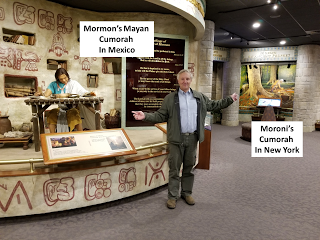I want to point out some details of “Moroni’s Cumorah,” which our LDS intellectuals describe as “a hill in New York” where Moroni deposited the plates after walking 2,400 miles north from the “real Cumorah” they are still searching for in southern Mexico.
Why they’re looking in Mexico is a fun story for another day.
But for now, imagine you’re a missionary serving on Temple Square.
Millions of people visit Temple Square every year, and you take them to see this display of Mormon abridging the record in a Mayan cave. Then you take them across the hall (the distance representing the 2,400 miles) to New York where Moroni is burying the plates.
As a missionary, you hope your visitors don’t know anything about Church history, because if they do, they will ask questions you can’t answer without contradicting these displays.
For example, what happens when a visitor points out that Joseph Smith, Oliver Cowdery, Brigham Young, and every other prophet and apostle who has spoken on the issue has declared that there is one Cumorah and it is in New York?
Are you supposed to explain that these exhibits, which directly contradict the prophets, are wrong? Or are you supposed to say we believe the intellectuals now instead of the prophets?
Do you just hope no one asks the question? And how do you deal with the cognitive dissonance you feel every day when you walk through these displays?
_____
The problem is, these displays reflect what our intellectuals say, not what the scriptures and the prophets say.
Our intellectuals can’t explain Church history so they resort to magical thinking and invented scenarios that contradict what Joseph and Oliver explained.
You’re a missionary, taking a visitor to look at the display of Moroni on “a hill in New York.”
 |
| Lehi with the Liahona |
 |
| Moroni puts the Liahona in the stone box |
 |
| Moroni puts the sword of Laban in the stone box |
Source: Book of Mormon Wars






